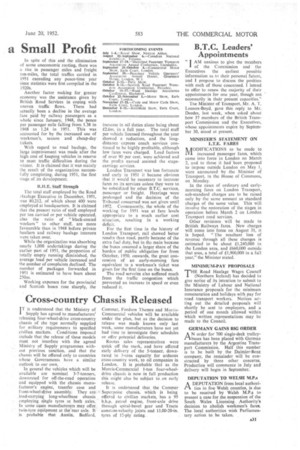a Small Profit
Page 33

If you've noticed an error in this article please click here to report it so we can fix it.
In spite of this and the elimination of some uneconomic routing, there was a rise in passenger miles and freight ton-miles, the total traffics carried in 1951 exceeding any peace-time year since statistics were first compiled in the 1920s.
Another factor making for greater economy was the assistance given by British Road Services in coping with uneven traffic flows. There had actually been a decline in the average fare paid by railway passengers as a whole since January, 1948, the pence per passenger mile falling from L38 in 1948 to 1.24 in 1951. This was accounted for by the increased use of workmen's, season and cheap-day tickets.
With regard to road haulage, the large improvement was made after the high cost of keeping vehicles in reserve to meet traffic . difficulties during the winter. It is claimed that it was mainly the result of the organization successfully completing, during 1951, the first stage of its development. .
R.H.E. Staff Strength
The total staff employed by the Road liaulage Executive in December, 1951, was 80,212, of which about 400 were employed at headquarters. Jt is claimed that the present ratio of staff employed per ton carried or per vehicle operated, also the ratio of "black-coated workers" to other staff, are more favourable than in 1948 before private hauliers and railway haulage interests were taken over.
While the organization was absorbing nearly 1,000 undertakings during the earlier part of 1951, the proportion of totally empty running diminished, the average load per vehicle increased and the number of complaints declined. The number of packages forwarded in 1951 is estimated to have been about 250m.
Working expenses for the provincial and Scottish buses rose sharply, the increase in oil duties alone being about £2.6m. in a full year. The total staff per vehicle licensed throughout the year showed a reduction, and the longdistance express coach, services continued to be highly profitable, although low fares were charged. Load factors of over 90 per cent, were achieved and the profits earned assisted the stagecarri age services.
London Transport was less fortunate and early in 1951 it became obvious that it would be necessary to increase fares on its services unless they were to be subsidized by other B.T.C. services, passenger or freight. Hearings were prolonged and the decision of the Tribunal concerned was not given until 1952. Consequently, the whole of the work ing for 1951 was at fare levels appropriate to a much earlier cost situation, resulting in a working deficit.
For the first time in the history of London Transport, rail showed better results than road, partly because of the extra fuel duty, but in tha main because the buses assumed a larger share of the burden of public obligation for from -October, 1950, onwards, the great concession of an early-morning fare equivalent to a workman's ticket was given for the first time on the buses.
The road servcies also suffered much from the traffic congestion which prevented an increase in speed or even reduced it.




















































































